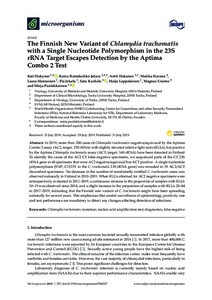The Finnish New Variant of Chlamydia trachomatis with a Single Nucleotide Polymorphism in the 23S rRNA Target Escapes Detection by the Aptima Combo 2 Test
Kati Hokynar; Kaisu Rantakokko-Jalava; Antti Hakanen; Marika Havana; Laura Mannonen; Pia Jokela; Satu Kurkela; Maija Lappalainen; Magnus Unemo; Mirja Puolakkainen
The Finnish New Variant of Chlamydia trachomatis with a Single Nucleotide Polymorphism in the 23S rRNA Target Escapes Detection by the Aptima Combo 2 Test
Kati Hokynar
Kaisu Rantakokko-Jalava
Antti Hakanen
Marika Havana
Laura Mannonen
Pia Jokela
Satu Kurkela
Maija Lappalainen
Magnus Unemo
Mirja Puolakkainen
MDPI
Julkaisun pysyvä osoite on:
https://urn.fi/URN:NBN:fi-fe2021042827272
https://urn.fi/URN:NBN:fi-fe2021042827272
Tiivistelmä
In 2019, more than 200 cases of Chlamydia trachomatis negative/equivocal by the Aptima Combo 2 assay (AC2, target: 23S rRNA) with slightly elevated relative light units (RLUs), but positive by the Aptima Chlamydia trachomatis assay (ACT, target: 16S rRNA) have been detected in Finland To identify the cause of the AC2 CT false-negative specimens, we sequenced parts of the CT 23S rRNA gene in 40 specimens that were AC2 negative/equivocal but ACT positive. A single nucleotide polymorphism (SNP; C1515T in the C. trachomatis 23S rRNA gene) was revealed in 39 AC2/ACT discordant specimens. No decrease in the number of mandatorily notified C. trachomatis cases was observed nationally in Finland in 2010-2019. When RLUs obtained for AC2 negative specimens were retrospectively evaluated in 2011-2019, a continuous increase in the proportion of samples with RLUs 10-19 was observed since 2014, and a slight increase in the proportion of samples with RLUs 20-84 in 2017-2019, indicating that the Finnish new variant of C. trachomatis might have been spreading nationally for several years. This emphasizes that careful surveillance of epidemiology, positivity rate and test performance are mandatory to detect any changes affecting detection of infections.
Kokoelmat
- Rinnakkaistallenteet [27094]
